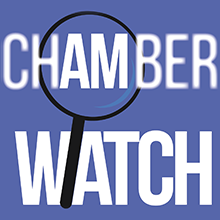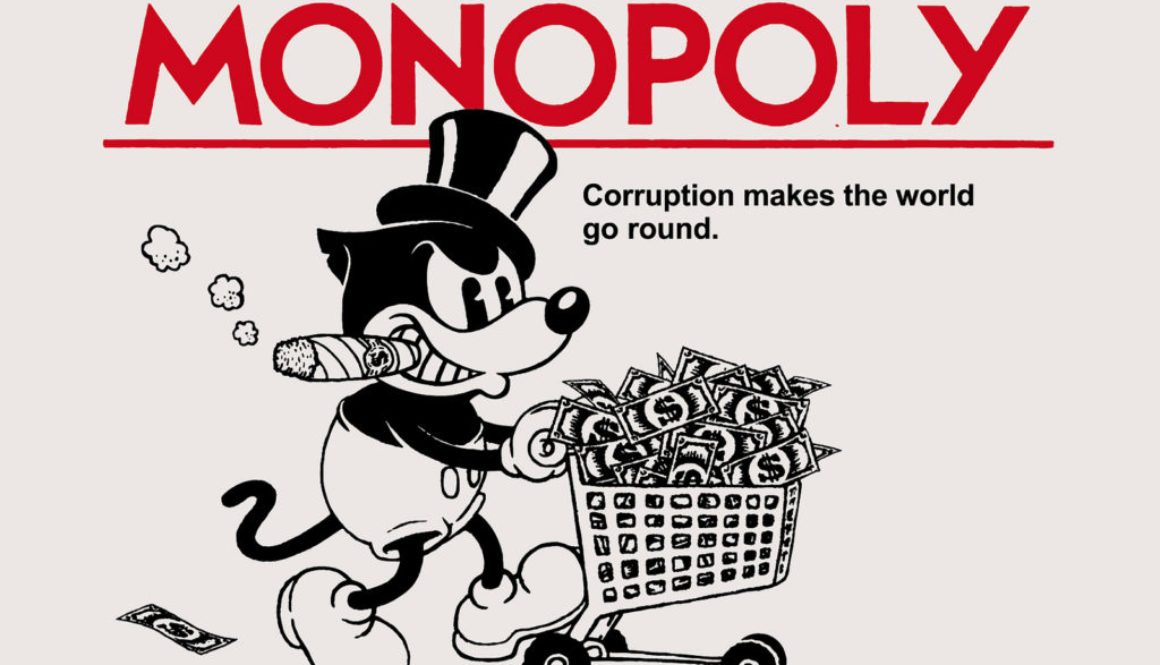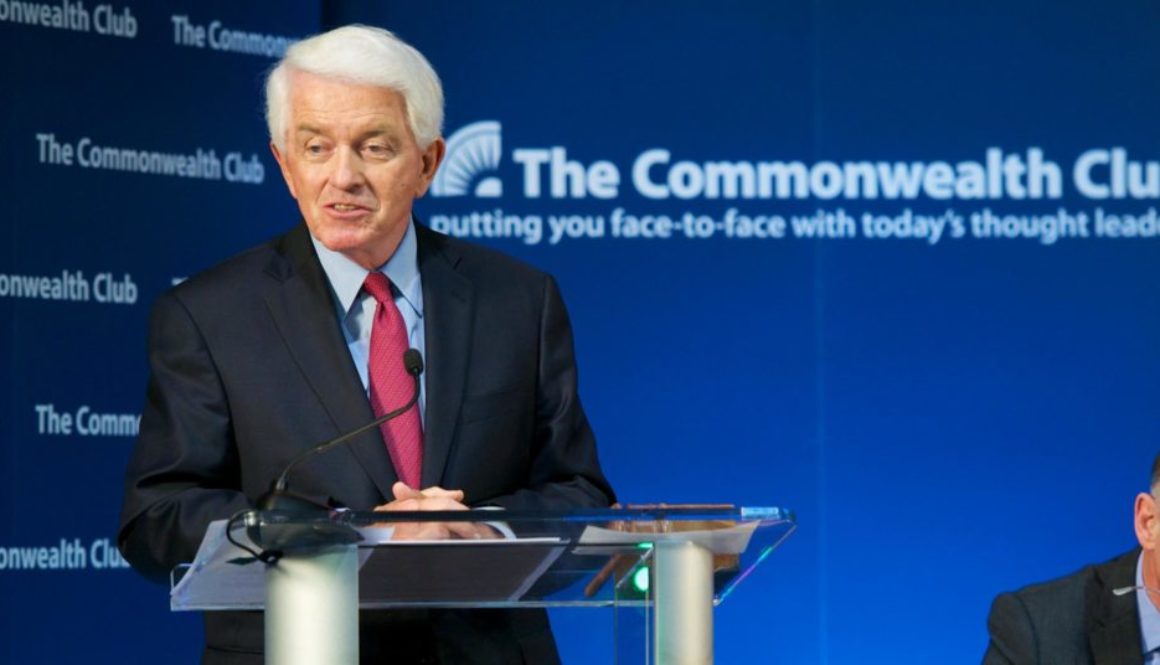Download the .pdf version of this report here.
The 2016 election cycle was the first time in the Citizens United era that the U.S. Chamber of Commerce (Chamber) devoted its general election spending exclusively to benefiting Republican candidates.[1] For the contests in which the Chamber indicated which candidate it supported in the 2018 election cycle, the same partisan pattern held true. And, though the Chamber’s reported election spending in 2018 was significantly less than in the 2014 and 2016 cycles, the relatively huge amounts of secret money it continues to dump into races creates ongoing damage to the American democracy.
The Chamber was the largest non-disclosing outside spender in more than half of the races in which it got involved, and it was the second-largest overall spender of money from undisclosed sources in the 2018 congressional races.
“Outside spending” refers to electioneering spending done by parties besides candidates’ campaigns. This includes spending done by conventional party committees, political action committees (PACs) and super PACs, nonprofit organizations and trade associations. Legally, this spending may not be coordinated with campaigns, but laws and enforcement governing coordination are weak.
The Chamber is a trade association organized under section 501(c)(6) of the tax code. Unlike PACs and super PACs, which must disclose their donors, groups organized under section 501(c) are not required to disclose the sources of their funding. Outside spending from these non-disclosing groups is referred to as “dark money” or “secret money” because its funding source is unknown to the public. But 501(c) groups must still report certain details of their spending to influence elections to the Federal Election Commission.[2]
Public Citizen’s position is that efforts to influence elections by outside entities should be regulated in much the same way as donations to candidates’ campaigns. This is to say that only human beings should be allowed to make contributions to entities that spend on elections, and these contributions should be limited to somewhere in the neighborhood of $5,000 per year, as used to be the case. The U.S. Supreme Court struck a devastating blow to campaign finance rules in its 2010 Citizens United v. Federal Election Commission decision, which ended restrictions on spending to influence elections by corporations, unions, and nonprofit entities, such as the U.S. Chamber of Commerce. Until that decision is either overturned or negated by a constitutional amendment, Public Citizen’s position is that outside entities spending in elections should at least have to disclose their sources of funds so that the public can evaluate the motives of those who underwrite political advertisements. The promise of such disclosure was among the key rationales articulated by the Supreme Court in its Citizens United decision.[3]
Spending to Influence Elections
Even though we do not know who provides the U.S. Chamber with its funding, we do know roughly the amount of money that it is spending in elections. The Chamber disclosed spending $10.9 million on congressional races during the 2018 election cycle, making it the second largest spender of secret money on congressional races in 2018 after Majority Forward. [See Table 1] Majority Forward is a 501(c)(4) group affiliated with Senate Majority PAC[4], which is a super PAC that is essentially operated by the Democratic leadership of the U.S. Senate.[5]
While all secret spending in American elections warrants criticism, this report focuses on the election spending by the Chamber as part of Public Citizen’s ongoing oversight of the trade association through our Chamber Watch project. We have undertaken this effort to track its election spending because the Chamber is an outspoken opponent of laws that require disclosing the sources behind electioneering spending, and because its highly partisan election spending profile contradicts its claim that it seeks to support all businesses. Instead, its agenda disproportionately benefits Big Business, and it pushes anti-regulatory causes and industries that are favorites of conservatives in Congress.
Table 1: Spending by Top 10 Non-Disclosing Outside Groups in 2018 Congressional Elections
| Rank |
Group |
Total |
View* |
| 1 |
Majority Forward |
$45,481,168 |
L |
| 2 |
U.S. Chamber of Commerce |
$10,908,413 |
C |
| 3 |
National Association of Realtors |
$10,828,820 |
X |
| 4 |
Americans for Prosperity |
$8,936,439 |
C |
| 5 |
Patients for Affordable Drugs Action |
$7,961,084 |
X |
| 6 |
Patriot Majority USA |
$5,745,176 |
L |
| 7 |
Everytown for Gun Safety |
$5,109,291 |
L |
| 8 |
Environmental Defense Action Fund |
$4,777,138 |
L |
| 9 |
Black PAC |
$4,467,572 |
L |
| 10 |
American Chemistry Council |
$3,387,335 |
X |
Source: Center for Responsive Politics (www.opensecrets.org)
*View: C = Conservative, L = Liberal, X=Bi-Partisan, as determined by the Center for Responsive Politics
Of the $10.9 million that the Chamber spent in the 2018 cycle, about $7.5 million was devoted to spending categorized as “independent expenditures,” with the rest being for those categorized as “electioneering communications.” Independent expenditures regard expenditures that are expressly intended to support or oppose a candidate. An example would be an advertisement that refers to the candidate by name and invokes words such as “vote for,” “support,” or “defeat.”[6] By contrast, electioneering communications refer to a candidate in the run-up to an election but do not use express advocacy words. This was the first election cycle since 2012[7] in which the Chamber reported using electioneering communications.[8]
Partisan Spending
The Chamber sought to influence 22 congressional races in 2018 –17 through the use of independent expenditures, and 5 through the use of electioneering communications. The Chamber was the top outside spender in 13 of those races. The Chamber spent significantly less on congressional races in 2018 compared to 2016, decreasing from $29.4 million to only $10.9 million. The Chamber’s average spending per race decreased as well, down from around $1.8 million per race in 2016 to just under $0.5 million in 2018. [See Table 2]
Table 2: Chamber Outside Spending in 2018 Cycle Congressional Contests
| |
Race (District for House Contests) |
Candidates |
U.S. Chamber Outside Spending |
Type of Spending |
Chamber’s Favored Candidate |
U.S. Chamber Rankings Among Nondisclosing Groups |
Outcome for Chamber-backed candidate** |
| 1 |
Ga. House 06 (2017 special election) |
Ossoff (D) v. Handel (R) |
$1,153,841
|
IE |
Handel (R) |
4 of 9 |
W-Special |
| 2 |
Miss. Senate |
Espy (D) v. Hyde-Smith (R) |
$1,050,000 |
IE |
Hyde-Smith (R) |
4 of 23 |
W-Special |
| 3 |
Ariz. Senate |
Sinema (D) v. McSally (R) |
$1,000,000 |
EC |
McSally (R) |
2 of 25 |
L |
| 4 |
Mont. Senate |
Rosendale (R) v. Tester (D) |
$1,000,000 |
EC |
Rosendale (R) |
2 of 17 |
L |
| 5 |
Ala. Senate* |
Moore (R) v. Strange (R) |
$965,650 |
IE |
Strange (R) |
1 of 19 |
L-Special |
| 6 |
Fla. Senate |
Scott (R) v. Nelson (D) |
$750,000 |
IE |
Scott (R) |
3 of 22 |
W |
| 7 |
Tenn. Senate |
Bredesen (D) v. Blackburn (R) |
$750,000 |
EC |
Blackburn (R) |
4 of 13 |
W |
| 8 |
Ind. Senate |
Braun (R) v. Donnelly (D) |
$500,000 |
EC |
Braun (R) |
4 of 21 |
W |
| 9 |
Va. House 10 |
Wexton (D) v. Comstock (R) |
$350,000 |
IE |
Comstock (R) |
1 of 14 |
L |
| 10 |
Fla. House 26 |
Mucarsel-Powell (D) v. Curbelo (R) |
$350,000 |
IE |
Curbelo (R) |
1 of 11 |
L |
| 11 |
N.Y. House 11 |
Rose (D) v. Donovan (R) |
$350,000 |
IE |
Donovan (R) |
1 of 2 |
L |
| 12 |
Ala. House 02 |
Isner (D) v. Roby (R) |
$342,902 |
IE |
Roby (R) |
1 of 5 |
W |
| 13 |
Ohio House 16 |
Moran Palmer (D) v. Gonzalez (R) |
$300,000 |
IE |
Gonzalez (R) |
1 of 3 |
W |
| 14 |
Texas House 23 |
Ortiz Jones (D) v. Hurd (R) |
$300,000 |
IE |
Hurd (R) |
1 of 8 |
W |
| 15 |
S.C. House 5* |
Pope (R) v. Norman (R) |
$252,868 |
IE |
Pope (R) |
3 of 6 |
L |
| 16 |
Mont. House 1 (2017 special election) |
Quist (D) v. Gianforte (R) |
$250,250 |
IE |
Gianforte (R) |
1 of 12 |
W-Special |
| 17 |
Neb. House 2 |
Eastman (D) v. Bacon (R) |
$250,000 |
IE |
Bacon (R) |
1 of 4 |
W |
| 18 |
Minn. House 3 |
Philips (D) v. Paulsen (R) |
$250,000 |
IE |
Paulsen (R) |
1 of 7 |
L |
| 19 |
Calif. House 45 |
Porter (D) v. Walters (R) |
$250,000 |
IE |
Walters (R) |
1 of 15 |
L |
| 20 |
Wash. House 8 |
Schrier (D) v. Rossi (R) |
$200,000 |
IE |
Rossi (R) |
1 of 13 |
L |
| 21 |
Kan. House 3 |
Davids (D) v. Yoder (R) |
$200,000 |
EC |
Yoder (R) |
2 of 7 |
L |
| 22 |
Ala. House 02* |
Bright (R) v. Roby (R) |
$92,092 |
IE |
Roby (R) |
1 of 1 |
W |
| Total |
|
|
$10,907,603
|
|
|
|
|
Sources: Center for Responsive Politics (www.opensecrets.org) and Federal Election Commission (https://www.fec.gov/data/electioneering-communications/) *Primary Election **Assumes Chamber sought to assist Republican candidate in races in which it only reported making electioneering communications.
In 100 percent of races in which the Chamber made independent expenditures, its money went toward assisting Republican candidates. For races in which the Chamber made electioneering communications rather than independent expenditures, we assume in this report – based on the Chamber‘s fully partisan independent expenditures – that the Chamber aimed to help the Republican, as well. In 2016, the Chamber-backed candidate won in 13 out of 16 races (81 percent). In 2018, the Chamber-backed candidate won in only 11 of 22 races (50 percent).
The Chamber’s Unconvincing Image Rehabilitation
Despite continuing to spend exclusively on Republican candidates, the Chamber’s rhetoric since the election has feinted toward increased valuation of bipartisanship. For instance, the Chamber’s scorecard for legislators now includes a “bipartisan engagement score,”[9] though this only accounts for 10 percent of a legislator’s score. Tom Wilson, the chairman of the Chamber’s board of directors and CEO of Allcorp, stated recently that “It’s not just about telling a different story. We have to fundamentally act differently, too … We need to be more accessible and more bipartisan than we were.”[10]
Despite this claim of a new, more bipartisan Chamber, its agenda is as regressive as ever: anti-environment, anti-worker, anti-consumer.
For instance, during the January 2019 State of American Business Address, Chamber CEO Thomas J. Donohue said the Chamber was putting “all of our resources” toward lobbying against single-payer healthcare.[11] Indeed, the Chamber has followed through on this promise, forming a coalition of well-heeled American groups representing varied private health industries called the Partnership for America’s Health Care Future in order to lobby against Medicare-for-All.[12]
Just this year, through its Global Energy Institute, the Chamber revealed its new “American Energy: Cleaner, Stronger” agenda.[13] This agenda is a microcosm of the Chamber’s broader PR makeover: its ultimate policy recommendations are the same ones the Chamber has been pushing for years, namely deregulation and deference to the private sector and continued reliance on fossil fuels.[14]
And in December, the Chamber issued its annual list of the top 10 “Most Ridiculous Lawsuits” of 2018.[15] This list aims to make civil justice litigation look frivolous and laughable, as a backdrop to the Chamber’s ongoing efforts to advocate for legislative changes that would insulate corporations from these suits and weaken consumers’ and workers’ ability to bring them to seek justice for harm.
Conclusion
While the Chamber’s congressional campaign spending in 2018 was reduced as compared to other recent election cycles, it was still the second largest spender of secret money. Election spending by non-disclosing outside groups such as the Chamber is a key element of the United States’ opaque campaign finance system. In the post-Citizen United environment, massive election spending by groups whose donors remain unknown threatens to allow anonymous wealthy donors to drown out average citizens’ voices without even revealing who they are.
Moreover, the findings in this report make it clear that through the 2018 cycle, the Chamber remains a markedly partisan organization. Despite the Chamber’s claims of having seen the light and embraced bipartisanship, and its shiny new PR makeover, the facts show that the Chamber’s alignment remains with the Republican Party and a conservative, regressive policy agenda.
Companies that fund the Chamber should see the Chamber’s bipartisanship claims for what they are: a way to continue pushing deeply conservative policies in an era when the GOP no longer has unified control of Congress. These companies should think twice about continuing to fund the Chamber when it has shown no desire whatsoever to change its underlying agenda.
[1] Grace Aylmer, Public Citizen, The Republican Party And The Chamber Of Secrets (December 7, 2016), https://bit.ly/2stqD2W.
[2] The FEC and Federal Campaign Finance Law, Independent Expenditures, Federal Election Commission (viewed on April 30, 2019), http://bit.ly/2gvOAVv.
[3] Citizens United v. Federal Election Commission, 558 U.S. 310 (2010), http://bit.ly/2W5KJiR.
[4] Maggie Severns, Democratic, GOP Super PACs Quadruple Fundraising As Big-Money Groups’ Influence Grows, Politico (December 7, 2018), http://bit.ly/sa2ab34.
[5] Carrie Levine, Democratic Super PAC Aided By Secret Money, The Center For Public Integrity (January 29, 2016), http://bit.ly/2vuZkJn.
[6] What Super PACs, Non-Profits, and other Groups Spending Outside Money Must Disclose about the Source and Use of their Funds, Opensecrets.Org (viewed April 30, 2019), https://bit.ly/2Ibfek7.
[7] Browse electioneering communications, Federal Election Commission, (viewed on April 30, 2019), http://bit.ly/2GSicbs.
[8] From 2012 to 2016, there existed a legal incentive for non-disclosing groups to prioritize individual expenditures over electioneering communications established through Van Hollen v. FEC 15-56 (D.C. Cir. 2012) though that decision was reversed in a 2016 appeals court ruling (see http://bit.ly/2DEyAKQ). More recently, in a district court ruling in CREW v. FEC (Case No. 16-0259) (2018), the FEC was directed to undergo rulemaking and nullify the earmarking loophole for both electioneering communications and independent expenditures. This is still pending before the FEC.
[9] Carl Hulse, Chamber Of Commerce Decides Bipartisanship Is Good Business, The New York Times (Feb 2, 2019), https://nyti.ms/2ZB5kh9.
[10] James Hohmann, The Daily 202: The U.S. Chamber Wants To Disentangle Its Brand From The GOP And Hopes To Rebuild The Center, The Washington Post (April 25, 2019), https://wapo.st/2W9fgwy.
[11] Craig Sandler, New Year, New Congress—Same Old Chamber, Chamber Watch (January 10, 2019), http://bit.ly/2IHb18g.
[12] Craig Sandler, The US Chamber of Commerce’s Cabal Opposing Medicare-for-All is No “Justice League”, Chamber Watch (February 13, 2019), http://bit.ly/2JAb5X4.
[13] Global Energy Institute Unveils American Energy: Cleaner, Stronger Agenda, Global Energy Institute (April 2019), http://bit.ly/2WGIbIo.
[14] Craig Sandler, Don’t Believe the Hype: The Chamber’s “Cleaner, Stronger” Energy Agenda is Merely a PR Stunt, Chamber Watch (May 1, 2019), http://bit.ly/2VCr5il.
[15] It’s Time for the 2018 Top 10 Most Ridiculous Lawsuits, U.S. Chamber of Commerce (December 18, 2019), https://uscham.com/2vVZKbB.
This report was originally published on Public Citizen’s website. U.S. Chamber Watch is a project of Public Citizen. If you’d like to learn more about the Chamber, you can always visit us on www.chamberofcommercewatch.org or follow us on Facebook and Twitter.





